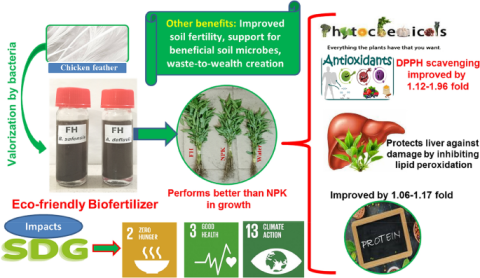Application of bacterial feather hydrolysates as biofertilizers in growing leafy vegetables: yield, nutritional, phytochemical, antioxidant and hepatoprotective profiles
In 2023, we showed that feather hydrolysates promoted the growth of vegetables on the field and improved their functional properties........
The present study reports the application of feather hydrolysates (FHs) obtained from the hydrolysis of chicken feathers by Bacillus safensis LAU 13 (KJ461434) and Aquamicrobium defluvii FH 20 (OM281847.1) as organic nitrogen fertilizer for the cultivation of Corchorus olitorius, Celosia argentea and Amaranthus caudatus. Foliar treatment of the vegetables with FHs (100%, v/v) remarkably improved their growth and yield performances. The FHs induced over 1.5-fold improvement in root length, shoot height, shoot fresh weight, dry weight, leaf number, leaf area and chlorophyll contents of the vegetables compared to water after 6 weeks of cultivation. In most cases, FHs at optimal levels displayed better growth promotion than NPK fertilizer. FHs elevated the nitrogen content (25.53–29.79%), organic carbon (33.77–38.96%), and microbial load (102–104 cfu/g) of soil after 6 weeks. Vegetables fertilized with FHs showed improvements in crude protein, crude fibre, ash, phenols, flavonoids, and proanthocyanidin contents to controls. Also, about 1.1-fold improvement in hydrogen peroxide and DPPH radicals scavenging activities was obtained. Significant lipid peroxidation inhibition against ferrous ion (Fe2+) damage in precision-cut liver slices with higher catalase activities was recorded. Thus, the bacterial FHs significantly enhanced the growth, nutritional and antioxidant properties of the vegetables as well as soil nutrient and biological activities. Hence, the application of the bacterial FHs can be substituted for synthetic fertilizer to promote sustainable agricultural food production in an ecologically benign manner.
Published in Clean Technologies and Environmental Policy: Link

